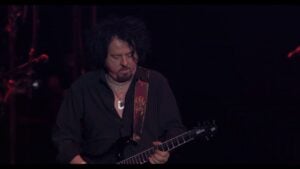Why Did We Standardized The E Tuning In Guitar?

The-Art-of-Guitar / YouTube
We all know it by heart – E-A-D-G-B-E. The notes that unlock a world of musical expression for countless guitarists. But have you ever stopped to wonder why this particular tuning reigns supreme?
This seemingly simple question takes us on a fascinating historical journey. We’ll explore the evolution of stringed instruments, uncovering the reasons why E tuning rose to prominence among its many competitors.
Delving deeper, we’ll discover the practical and musical advantages that keep E tuning the go-to choice for guitarists today, even centuries after its rise. So grab your axe, or simply lend us your ear, as we delve into the world of guitar tuning!
The Chicken or the Egg of Stringed Instruments?
The origins of stringed instruments are shrouded in mystery, and instrument historians continue to debate the very first spark of this musical marvel. One popular theory suggests that the hunting bow was the precursor, its string vibrating with a sound that piqued our curiosity.
Another school of thought flips this idea on its head, proposing that stringed instruments actually came before bows, their twang repurposed for hunting purposes. This debate boils down to a fundamental question: Did the need for survival come before the desire for music?
Personally, we find it more likely that a bored hunter, waiting for prey, discovered the musical potential of their bowstring. Perhaps a stray pluck revealed a pleasing tone, and further experimentation with tension unlocked a range of pitches, igniting a spark of creativity that would one day blossom into the rich tapestry of music we know today.
Tuning the Seeds of Modern Guitar
The lute, a popular instrument for centuries, laid the groundwork for the construction of the modern guitar. It’s also where the roots of standard tuning can be traced. Lutes came in various styles, each with its own unique tuning system.
Interestingly, one lute variation employed a tuning of E-A-D-F#-B-E, which some might recognize from the occasional off-key cover band! This tuning bears a striking resemblance to standard tuning, differing by only a single half step on one string.
The 16th century saw the introduction of the Baroque guitar, a five-string instrument tuned ADGBE. This tuning is practically identical to our modern standard, but lacks the low E string. This five-string configuration eventually evolved into the six-string guitar we know today, with the addition of that crucial low E string, solidifying the now-ubiquitous standard tuning.
Standard Tuning is a Gateway to Musical Expression
Standard tuning, with its E-A-D-G-B-E string configuration, was designed with practicality in mind. It allows guitarists to form basic chords and play simple melodies with relative ease, making it an ideal starting point for beginners.
This seemingly straightforward tuning, however, unlocks a surprising depth of musical expression. The vast amount of music written and recorded in standard tuning across all genres is a testament to its versatility. It provides a strong foundation for learning chord shapes and fingerings, empowering musicians to create a wide range of sounds.
While some artists remain comfortable within the confines of standard tuning throughout their careers, others venture out to explore the sonic possibilities offered by alternative tunings. Standard tuning serves as a gateway, allowing guitarists to embark on a lifelong journey of musical exploration.
Beyond Standard Tuning
For many guitarists who grew up in the late 80s and early 90s, alternative tunings like Drop D (DADGBE) or Open D (DADF#AD) were a game-changer. These tunings allowed for barre chords to be formed with just one finger, a revelation for self-taught players. Back then, learning by ear was the only option, and let’s just say a lot of early attempts were, shall we say, creatively unique.
One strategy people still use today to break out of playing the same old riffs is random de-tuning. This involves loosening the strings and then tuning each one to the closest note in pitch. The result is a completely new and unexpected tuning.
It becomes a puzzle to solve, forcing creative guitarists to analyze the fretboard and discover new finger patterns. This exercise has not only led to some surprisingly cool tunings, but it’s also a fantastic way to develop a deeper understanding of the instrument’s sonic potential.











